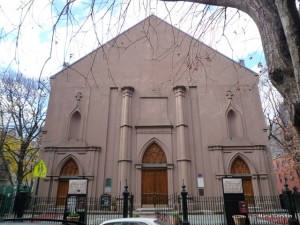Usually, “talking to the walls” is a frustrating, unproductive endeavor. You try to get your point across, but the person with whom you’re speaking is so obstinate that you might as well be debating with masonry. Luckily, the walls in New York talk back and, like most people who live in this city, they’ve got much to say.
I didn’t always look to concrete for conversation. This odd habit began one afternoon last year during a visit to St. Patrick’s Old Cathedral in Little Italy. The next day the century-old church was being honored by decree of the Roman Catholic Pontiff Pope Benedict XVI as New York’s first basilica. Only 24 hours before the fanfare of the official ceremony began, the church stood empty—as glorious and elegant as it was in 1815. I’d read that St. Patrick’s had once been the scene of riots between Catholics and Protestants, battles ignited by ugly rumors involving infanticide. Openings had been carved into the walls of the church so that musket-bearing defenders could take aim at their enemies outside. But at that hushed moment, it was hard to imagine that chaos had ever plagued the building.
Back outside on Mott Street, where cafés and shops lined the sidewalk, a small, unassuming building stood across from the church like a silent witness to all that had occurred at St. Patrick’s over the years. “If walls could talk,” I thought. It turned out that that simple building held stories of its own.
The building, 256-258 Mott Street, used to be known as the 14th Ward Industrial School. John Jacob Astor and his wife Charlotte built it in 1888 to serve, in the words of the New York Times over 100 years ago, “a district of wretchedness, poverty and squalor.” They bought the lot for $21,000, hired Calvert Vaux (the co-architect of Central Park), and paid $42,000 for the construction of the Victorian Gothic structure. It became a school, run by the Children’s Aid Society, where impoverished immigrant children could receive daily lessons in “industry, thrift and cleanliness,” as well as hot meals. The little red brick building became a safe haven for generations of children in a neighborhood that used to be part of an infamously violent district.
So was finding out that a co-op building once owned by one of New York’s grandest families the thing that got me hooked me on wall-talking? Not entirely—it was also a ghoulish story set in a building that happened to be just around the corner on Prince Street.
On the day that I visited St. Patrick’s, vendors lined both sides of busy Prince Street. Tourists moved between kiosks buying hats and sunglasses, and visitors hurried in and out of a thrift store that was, until 2010, the parochial school associated with St. Patrick’s Old Cathedral. The festive scene on that sunny day held no evidence of the tragedy that occurred there 65 years earlier.
Christina Randazzo, a born and raised New Yorker, shared her story over coffee a few days later. “Sister Monica was our teacher and she would always say to us, ‘I just want to live long enough to see you all get to make your communion.’ On the day of the ceremony we stood inside the school in line, each child on a metal step, as she checked our veils and ties. We were quiet, preparing to lead the procession into [St. Patrick’s] across the street. She stood on the first landing as she said a prayer.” Ms. Randazzo recalled what happened next as if describing a harrowing scene from a film playing in slow motion:
“She stepped back and her heel must have caught in the hem of her habit because she fell backwards, hitting all the way down along those metal steps. She died instantly.” As a priest came to read last rites to Sister Monica, another nun led the children across Prince Street into St. Patrick’s. “We were in blood splattered communion dresses. We went to our communion, walking ashen down the center of the church.”
And so, while visiting an old cathedral, I’d discovered a church’s unusual history, a building’s heroic past, and stairs with a gothic tale. I realized just how much of New York we miss as we hurry past the buildings that stand quietly around us each day. Since then I’ve been pausing to “listen” to buildings, and I’ll share what I learn here. Stop by again for a story or two—you might be surprised by what New York buildings have to say.













Thomas
Love this story, Maria brings her passion for the city to her writing. Glad she’s here and reporting the interesting things she sees that others don’t. Keep it up.
Adonia
Talking to the Walls. Loved the first one. When will I have the pleasure of reading the next one?
admin
Hey there Adonia,
“Talking to the Walls” comes out the 2nd Friday of each month, so only a few more days to wait!
Thanks for reading,
Ask a New Yorker